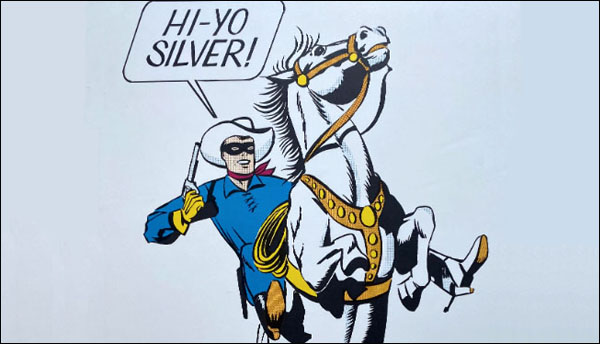
Suspended Animation #301
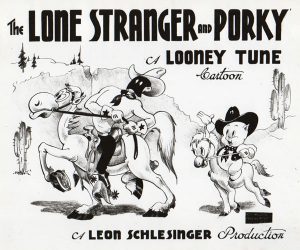 “A fiery horse with the speed of light, a cloud of dust and a hearty Hi-Yo Silver! The Lone Ranger! … With his faithful Indian companion Tonto, the daring and resourceful masked rider of the plains led the fight for law and order in the early western United States! Return with us now to those thrilling days of yesteryear! The Lone Ranger rides again!”
“A fiery horse with the speed of light, a cloud of dust and a hearty Hi-Yo Silver! The Lone Ranger! … With his faithful Indian companion Tonto, the daring and resourceful masked rider of the plains led the fight for law and order in the early western United States! Return with us now to those thrilling days of yesteryear! The Lone Ranger rides again!”
The fictional masked former Texas Ranger first appeared on a Detroit radio show in 1933 conceived by George Trendle and Fran Striker. The character became so popular that he appeared in novels, comic strips and comic books, movies, a television show and tons of merchandise.
So it is not surprising that he also was the subject for animation especially parodies like Bob Clampett’s The Lone Stranger and Porky (1939) where the Western hero (voiced by Billy Bletcher) saves stagecoach driver Porky from the bad guy.
Pathegrams
The earliest example of the Lone Ranger is animation is an undated two minute and forty second cartoon released by Pathegrams and produced by Roy Meredith sometime during the late 1930s.
The assumption has always been that it might have been done for some type of promotional use for Merita Bread that began sponsoring the popular Lone Ranger radio program at that time and produced multiple promotional items with the characters. Merita later sponsored the Lone Ranger television show as well.
The short cartoon is in black-and-white and is silent but has title cards for dialog and explanation. Some of the animation is quite good but is re-used frequently (sometimes even flipped so it is facing the other direction). No credits other than producer seem to exist for this oddity.
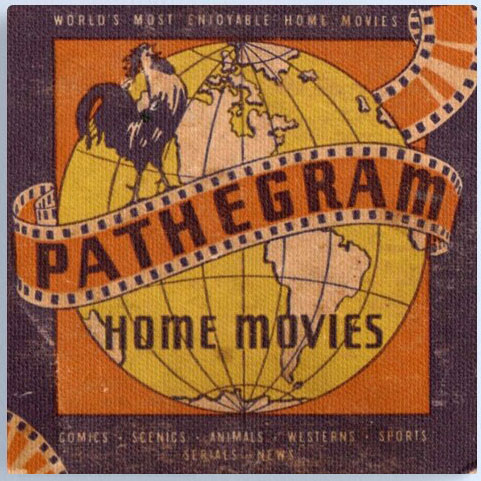
Pathegrams Presents The Lone Ranger. A Cartoon. Produced by Roy Meredith. The Masked Rider.
The Lone Ranger on his white horse Silver gallops on to the screen accompanied by Tonto on his horse Scout. The cactus and rock formations suggest the deserts of the southwest United States. In the distance, cattle are being herded across the screen.
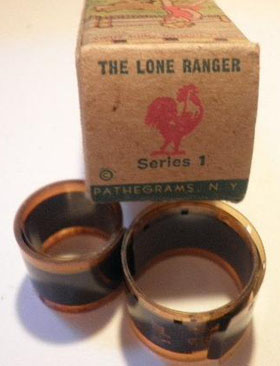 Tonto points and says: “What’s going on? Looks like cattle rustling. Let’s go!” They both ride off with the Lone Ranger shouting: “Hiegh-O (sic) Silver….away.”
Tonto points and says: “What’s going on? Looks like cattle rustling. Let’s go!” They both ride off with the Lone Ranger shouting: “Hiegh-O (sic) Silver….away.”
They find a battered old man hanging from the branch of a tree. Tonto points and shouts: “LOOK!” A title card states: “The work of cattle rustlers.”
The Lone Ranger shoots the rope holding the man so that he falls to the ground. They gather around the man who is still alive. He points off screen and says: “Get them! They stole my cattle!” The Lone Ranger and Tonto see the empty corral and the cattle being herded away.
“…After them Tonto!” shouts the Lone Ranger as he and Tonto ride their horses. “Hiegh-O (sic) Silver…Away.” The two rustlers take refuge behind some rocks and shoot at the two champions of justice.
The Lone Ranger tells his faithful Indian companion: “Tonto. Get behind those rocks…Quick.” The two return fire with seemingly unlimited ammunition from their six-shooters. After a short gun battle, the rustlers tie white handkerchiefs to the tips of their rifles and wave them in the air to surrender. They stand up and raise their hands.
Without taking them into custody, tying them up or handing them over to the authorities, the Lone Ranger and Tonto ride back to the rancher still on the ground. “We got ‘em, Rancher. Your herd’s safe,” says the Lone Ranger even though they never brought the herd back.
“The bandits are captured Tonto….our work here is finished,” summarizes the Lone Ranger as he and Tonto ride off.
Format Films
The first Lone Ranger animated television series aired for thirty episodes on CBS Saturday morning from September 10th, 1966 to September 6, 1969. It was produced by Herb Klynn and Jules Engel of Format films.
It included work by Art Babbit and Bill Tytla as directors among others and Virgil Ross as an animator. The animation was done by the Halas and Batchelor studio in England and Artransa Park Studios in Australia.
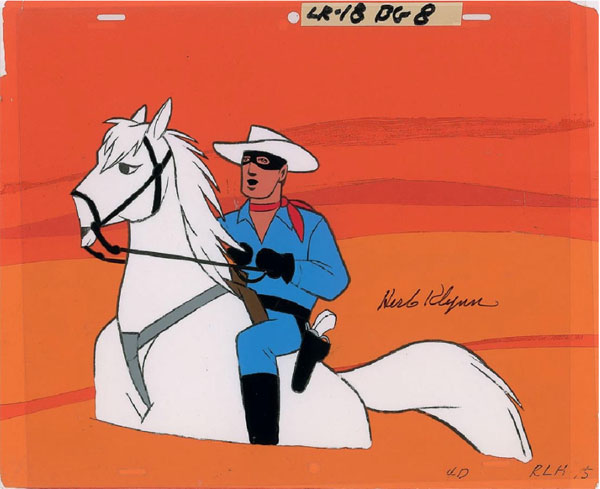
The opening theme song of the William Tell Overture was recorded in London with a forty piece orchestra including members from both The London Philharmonic and London Symphony orchestras.
“The thing we brought to The Lone Ranger,” said producer Herb Klynn, “was a totally new graphic.”
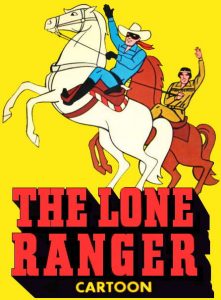 Multi-layered montaged backgrounds featuring shapes of luminous color held together by cels featuring illustrations that used grease pencils on the acetate instead of ink to get strong compelling black lines was used. Walt Peregoy was responsible for much of the background art.
Multi-layered montaged backgrounds featuring shapes of luminous color held together by cels featuring illustrations that used grease pencils on the acetate instead of ink to get strong compelling black lines was used. Walt Peregoy was responsible for much of the background art.
“Creative talent cannot be contained,” stated Klynn. “It must be allowed to breathe, to try new avenues…you have to experiment and go through a creative evolutionary process. That’s what we did. We were a team, a family with no boundaries.”
Each thirty minute episode was spilt into three separate segments with the middle segment being a solo adventure featuring Tonto voiced by Shepard Menken who did many voices for a variety of animation projects. Michael Rye was the voice of the Lone Ranger.
The narrator was Marvin Miller and the show had an impressive roster of other voices including Paul Winchell, Agnes Moorehead and Hans Conried.
This version of the Lone Ranger saga was heavily inspired by The Wild, Wild West live action television show that had debuted on CBS in 1965. It veered into science-fiction with its steampunk technology and stories with robots, space aliens and death rays. Like the Robert Conrad television show, the Ranger’s greatest villain was a little person who in this case was named Tiny Tom and voiced by Dick Beals.
Filmation
An animated Filmation Lone Ranger made his debut in a September 30th, 1972 episode of The Brady Kids. Bobby Brady is a big fan of the Lone Ranger.
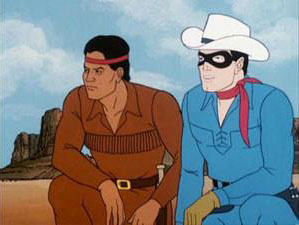 He wishes his new Lone Ranger Fan Club pin was real silver so Marlon, the magical mynah misunderstands and materializes the Lone Ranger’s horse by that name in the clubhouse. The Lone Ranger (John Erwin) and Tonto show up but are arrested by the police as members of the Masquerade Gang.
He wishes his new Lone Ranger Fan Club pin was real silver so Marlon, the magical mynah misunderstands and materializes the Lone Ranger’s horse by that name in the clubhouse. The Lone Ranger (John Erwin) and Tonto show up but are arrested by the police as members of the Masquerade Gang.
The New Adventures of the Lone Ranger ran for fourteen episodes (twenty-eight stories) on CBS Saturday morning from September 13th, 1980 –January 30th, 1982 as part of the Tarzan/Lone Ranger/Zorro Adventure Hour.
Filmation had success in the 1980s using rotoscoping to produce animated series with realistic human characters like Tarzan, Flash Gordon and Zorro. It was not much of a stretch to tackle The Lone Ranger.
Producer Lou Scheimer had approached actors Clayton Moore and Jay Silverheels to reprise their television roles for the animated series but Moore had reservations and so William Conrad agreed to voice the main character but insisted on being billed as “J. Darnoc” (Conrad spelled backwards).
Tonto was voiced by Ivan Naranjo, a Blackfoot/Southern Ute actor from Colorado and the character was made more articulate.
The series eschewed violence in keeping with programming concerns at the time and emphasized more of a historical approach with appearance by Ulysses S. Grant, Mark Twain and Wild Bill Hickcock. At the end of each episode the Masked Man would narrate a thirty second “history bite” in keeping with the show’s educational approach.


 Jim Korkis is an internationally respected animation historian who in recent years has devoted his attention to the many worlds of Disney. He was a columnist for a variety of animation magazines. With his former writing partner, John Cawley, he authored several animation related books including The Encyclopedia of Cartoon Superstars, How to Create Animation, Cartoon Confidential and Get Animated’s Animation Art Buyer’s Guide. He taught animation classes at the Disney Institute in Florida as well as instructing classes on acting and animation history for Disney Feature Animation: Florida.
Jim Korkis is an internationally respected animation historian who in recent years has devoted his attention to the many worlds of Disney. He was a columnist for a variety of animation magazines. With his former writing partner, John Cawley, he authored several animation related books including The Encyclopedia of Cartoon Superstars, How to Create Animation, Cartoon Confidential and Get Animated’s Animation Art Buyer’s Guide. He taught animation classes at the Disney Institute in Florida as well as instructing classes on acting and animation history for Disney Feature Animation: Florida.




















































“Hiegh-O”????? Some people take that “I before E” rule way too literally.
I used to know some old Detroit Symphony people who had played in the original radio program. The trumpet solo from the “William Tell” Overture that began every broadcast was played by Leonard B. Smith, the DSO’s principal trumpet and later director of the Detroit Concert Band. I interviewed him once when I was in college. He said “The Lone Ranger” was a great gig, as the music was all public domain classical pieces that were very familiar to the orchestra, and they had to do the whole show live every week, not once, but three times, for different time zones.
Spanish-speakers like my mother-in-law found “The Lone Ranger” very amusing. Not only is “tonto” the Spanish word for “stupid”, but “kemosabe” sounds like “quien no sabe”, or “he who doesn’t know”. However, this is only a remarkable coincidence; “Kee-Mo-Sah-Bee” was the name of a summer camp in northern Michigan where the director of the radio show sent his kids every year. But try telling my mother-in-law that.
That Pathegram cartoon is an interesting curiosity, but I doubt that any cartoon could have compared to what radio listeners visualised in their “theatre of the mind”.
Bobby Brady was a fan of the Lone Ranger? Funny, in the sitcom he was a fan of Jesse James.
Another animated parody would be, of course, Lenny Bruce’s Thank You Mask Man (1971).
It’s always pretty strange to see a silent film made in the 30s. By this point, sound had almost completely taken over, meaning 30s silents like that Lone Ranger cartoon stand out like a sore thumb. Why it was made that way, I have no idea. Maybe these were meant to be played at home? At any rate, once the silent era died out, silent films would only be made again as homages, like Mel Brooks’ Silent Movie or the 2013 Best Picture winner The Artist.
We shouldn’t be forgetting that Bob Clampett’s parody appeared twice in the Looney Tunes, also included as an extended trailer for a mock serial in Porky Pig’s “The Film Fan” (1939). There was also the getaway of the Thief of Baghdad on the back of Silver, doubled up with the Ranger, in Frank Tashlin’s “You’re an Education” for Warner (1938), which preceded the Clampett versions. Nor should we forget the expensive and elaborate parody produced by MGM, “The Lonesome Stranger” (1940), featuring some good voice work for Mel Blanc, and some rather far-out and goofy humor for the likes of an MGM cartoon of the period (including the running gag of the Indian messenger boy, whose coat reads on the back “The Vanishing American” – allowing him to disappear for each exit). While I haven’t had time in writing this reply on the fly for a thorough research, it also seems to me that there were many other cartoons which, while not featuring the ranger visually, had somebody or other doing variations of the “Heigh-Ho Silver” line, which in one cartoon changed Silver to “Tin Foil”, and in “The Film Fan” changed it to “You Know Who”. Some variant also appears in Warner’s later 40’s episode, “A Horse Fly Fleas”.
Another missed Ranger reference. In Tex Avery’s “Thugs With Dirty Muggs” (1940), Eddie G. Robemsome and his gang try to open a combination lock safe, but it turns out to be the tuning dial of a radio, which tunes in a broadcast of the Lone Stranger, with the call of “Heidi-Ho Silver” (reference to signature scat catch phrase of Cab Calloway). Think of the missed opportunity if some 30’s cartoon had ever had their ranger unmasked, and the face underneath turned out to be Rudy Vallee, complete with megaphone, uttering his catch-phrase, “Heigh-Ho, everybody!”.
Paul-
You need to tell your Mother-in-Law that “Tonto” was supposed to be the Potawatomi word for “wild one”. But more to the point, there are any number of words that mean vastly different things depending on the language. My favorite was the story of selling booze in Germany (and being a German speaker I can verify this one):
Once upon a time, the Dublin-based beverage distributor C&C Group decided to launch its popular brand of golden whiskey liqueur in Germany.
It seemed like a good plan. After all, Germany was a big market, and the name of the whiskey liqueur, “Irish Mist,” certainly had a nice ring to it.
To me, the name “Irish Mist” conjures up an image of a verdant field adorned with a fresh layer of morning dew; dew that is evaporating majestically into the glorious light beams of the rising sun.
Unfortunately, that’s not what Germans thought of when they heard the name.
You see, “mist” is the German word for “manure.” So while Germans may in fact have thought of a field when they heard the name “Irish Mist,” they probably didn’t think of a field adorned with dew: They probably thought of a field adorned with cow dung.
Needless to say, a beverage that translated to “Irish manure” didn’t exactly take off in Germany the way C&C Group had hoped.
That’s a funny story, John. One of my professors kept a file full of similar faux pas. My favourite was when General Motors wondered why their Chevrolet Nova wasn’t selling in Latin America, until someone pointed out that “no va” is Spanish for “won’t go.”
I grew up in a bilingual family, and we always got a laugh out of the Niagara Falls tour boat, Maid of the Mist.
An American friend of mine was an exchange student in Germany when she was seventeen. On her first day there, she took a walk in the park, went around a corner and bumped into a man urinating on a tree. “Gross!” she said, and he replied “Danke!” (People have told me this is an urban myth, but my friend swears it happened to her!)
I remember seeing an animated Buck Rogers short, apparently from the same vintage as that Lone Ranger cartoon..
Interesting that Michael Rye and William Conrad both played the Lone Ranger in cartoons. In 1949, Rye (then known as Rye Billsbury) played Marshal Dillon in the audition episode for “Gunsmoke,” and of course Conrad played the role when the series began on radio in 1952.
C&C (Cantrell and Cochrane) bought the RKO film library in the mid-50s and sold it to TV stations as “Movietime USA.” Because of a vault fire, some RKO films exist only in C&C prints.
Paul, I’ve investigated the Chevy Nova thing and that’s actually an urban legend. The truth is that the Chevrolet Nova’s name didn’t significantly affect its sales: it sold well in both its primary Spanish-language markets, Mexico and Venezuela, and its Venezuelan sales figures actually surpassed GM’s expectations.
It seems there’s a well-established brand of gas sold in Mexico by Pemex called Nova (you can look that up).
Finally, the phrase “no va” (literally “doesn’t go”) and the word “nova” are distinct entities with different pronunciations in Spanish: the former is two words and is pronounced with the accent on the second word; the latter is one word with the accent on the first syllable. Assuming that Spanish speakers would naturally see the word “nova” as equivalent to the phrase “no va” and think “Hey, this car doesn’t go!” is akin to assuming that English speakers wouldn’t buy a dinette set sold under the name Notable because nobody wants a dinette set that doesn’t include a table..
You can click on my name again to link to a 2008 debunking of this chestnut.
Another debunking! So many things my teachers told me have turned out not to be true.
RNigma: Don’t know of any vintage Buck Rogers cartoons. Any chance this is what you saw?
https://www.youtube.com/watch?v=qm4I8B3bFUA
As a kid I was a fan of the Format version of the Lone Ranger. It wasn’t really any better than the HB and Filmation shows that filled Saturday mornings, but it had a different look and sound. I never watched the Filmation version, feeling a sense of loyalty to the earlier show.
Billy Bletcher was also the dubbed voice of The Lone Ranger in the two serials from Republic Pictures. Since “The Lone Stranger” has a full face mask like the Ranger did in the serials, this cartoon may have been just as much a parody of them as it was of the radio series.
Billy Bletcher also is involved with the radio show. Always tight with a buck, George Trendle was having a salary dispute with Brace Beemer in spring, 1948. He hit upon the plan to bring Billy Bletcher in from California as a possible replacement for Beemer should they not be able to reach terms. Bletcher can be heard on the March 1, 1948 broadcast, “Letter From Albuquerque” and in several other Ranger programs during March. Then he disappears. One can conclude the experiment didn’t work out and Beemer signed his contract.
I’ve just transferred my 16mm print of this cartoon. Note the end admonishment by Roy Meredith!!
https://www.youtube.com/watch?v=NgWxerNFLKE